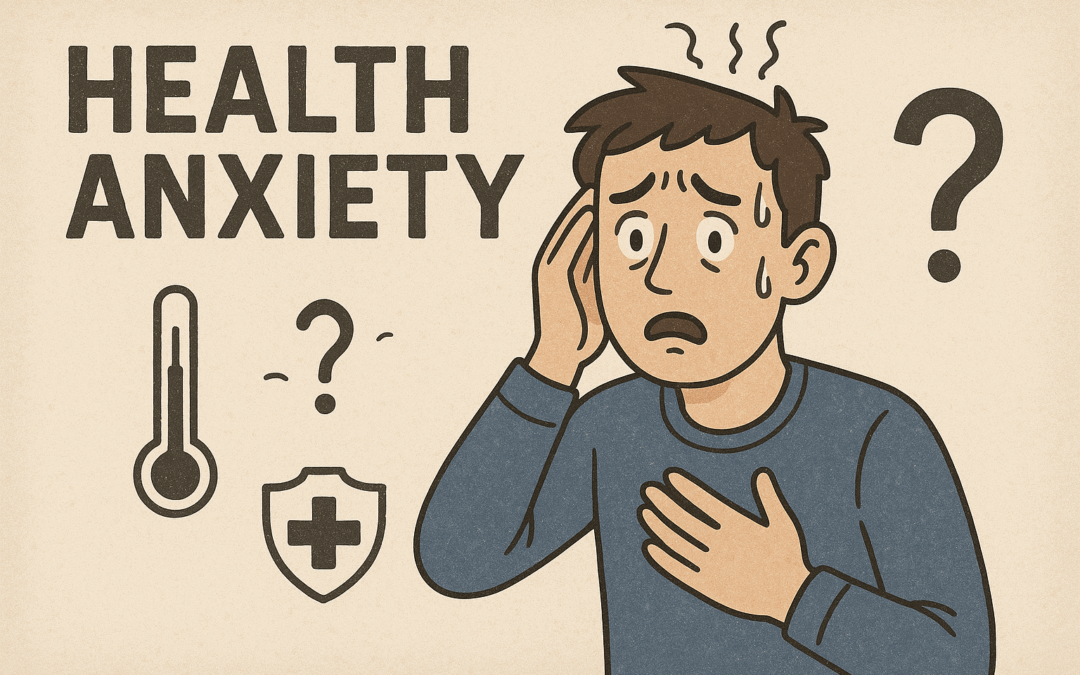Health anxiety is a common struggle I often encounter in therapy with my clients. It’s more than worrying about health – it’s the persistent fear that something is wrong with the body, despite medical reassurance. It often shows up as relentless symptom checking, doctor visits, late-night Googling, and an underlying dread of illness.
Health anxiety gets complex for me as a therapist who diagnoses the condition of illness anxiety disorder.
Sometimes I have a client where conventional medicine has failed them – and because of their own thorough scientific research and intuitive hits, they were able to resolve their symptoms or health challenges. This has been been done by changing to functional medicine practitioners, naturopaths, or finding health practitioners where my clients felt they could collaborate and have open and honest conversations. Different approaches have varied with changing medications, utilizing supplements and vitamins, getting to the root cause of symptoms, energy healing, variations with nutritional approaches, functional muscle massage, acupuncture, lymphatic drainage, and the list goes on.
The client was able to find healing because they didn’t trust the medical opinions they received, did their own research, and consulted with health practitioners who specialized in the areas of study they had conducted. This is where it gets confusing for me – some mental health clinicians would have labeled these individuals as having illness anxiety disorder. But the actions these individuals took are what healed them.
How Do I Approach Diagnosing Illness Anxiety Disorder?
As an integrative therapist, I value the healing approaches of conventional medicine and have walked alongside clients as they’ve worked through illness anxiety disorder. I’ve also had a good number of clients who were successful in their healing journey because of what was described above. So when I sit down with a new client who wonders if they might have health anxiety – or has been told this by a medical professional – I find myself considering several important things right from the start.
- Does this client have a history of trauma? Then specifically, is there a history of medical trauma?
- Why does this person feel like they might have health anxiety? What are the symptoms they are currently experiencing?
- Did a medical professional tell/suggest they might have health anxiety? If yes, which medical professional was this? Do they have a background in understanding anxiety? If the client was interested in getting a second opinion on the medical concerns they were experiencing, was the medical professional supportive of this?
- In general, how does this client feel about their relationship with their current health practitioners? Do they feel like they can have open and honest conversations about their health concerns? Do they feel like they get enough time with the health practitioner to discuss their concerns?
After collecting this information from my clients, it usually flows into three different approaches (or a combination of them). We discuss various approaches to healing for trauma and anxiety, collect more information to diagnose if illness anxiety disorder is present, and define what they value/look for in health practitioners and explore changing the health practitioners they are currently using.
 What does Health Anxiety look like?
What does Health Anxiety look like?
It’s characterized by excessive worry about having or developing a serious medical condition, despite little or no medical evidence to support these fears. It often involves:
- Hypervigilance to bodily sensations: Every twinge, heartbeat, or cough becomes a potential sign of disease.
- Avoidance behaviors: Steering clear of medical settings or information out of fear of confirmation of illness.
- Reassurance-seeking behaviors: Frequent doctor visits, online symptom searches, or constant checking of one’s body for abnormalities.
- Catastrophic thinking: Interpreting benign sensations as signs of life- threatening illness.
It’s important to emphasize that health anxiety is not simply “worrying too much.” For many, it’s rooted in deeper layers of past trauma, nervous system dysregulation, unresolved grief, or attachment wounds.
Common Patterns in Health Anxiety
Over the years, I’ve noticed recurring patterns in how health anxiety shows up for my clients:
- Distrust of Reassurance
When medical and health professionals confirm good health, and after a short while, doubt returns. Reassurance offers only mild and short-term relief because the root is not medical – it’s psychological and nervous system-based.
An important note is to make sure the client is in alignment with the medical and health professionals who are part of their health team. If they are not, sometimes part of the client’s distrust of their medical results may be warranted. It is essential for clear communication and collaboration to be established between the client and the different health practitioners.
With my client’s consent, I establish communication channels with the different health practitioners, and I have seen this work in greatly reducing the client’s health anxiety. The feedback I get from the practitioners I can use directly in the sessions with my clients. The health practitioners and I can also collaborate on the best approach when working with the client, ensuring we are on the same page.
- The Cycle of Checking and Relief
When an individual experiences a bodily sensation, a red mark on their skin, or their heart has palpitations for a second, etc they automatically go down the fear cycle. When the fear cycle hits, the person researchers or checks what these symptoms could possibly mean, potentially meets with a medical or health practitioner, or seeks reassurance in some other means and temporary relief follows. Then, when another potential symptom appears, the cycle starts all over again and again.
- Catastrophic Spirals
“This headache is probably a tumor,” or “My chest pain means I’m about to have a heart attack.” The mind leaps to worst-case scenarios without considering more common explanations.

Recognizing these patterns is the first step toward shifting them.
Potential Ways Health Anxiety Can Develop
When a client is experiencing health anxiety, most of the reasons play off of each other – it usually doesn’t happen in isolation. It often reflects the interplay of biology, psychology, and lived experience. Some common contributing factors include:
- Trauma and the Body
Trauma survivors often experience heightened interoception – the body’s awareness of internal signals. When the nervous system is stuck in a fight-flight-freeze loop, ordinary sensations (like a racing heart) can feel dangerous. Health anxiety can be understood as a trauma echo, where the body’s vigilance is misinterpreted as signs of impending illness.
- Early Experiences with Illness or Loss
If someone grew up in a household where a parent was ill, or where a sudden loss occurred, their nervous system may have learned that bodies are unpredictable and fragile. This can seed a lifelong hyper-awareness of physical symptoms.

- The Need for Control
For many, focusing on health becomes a way to manage uncertainty. If life feels unpredictable or unsafe, monitoring the body offers an illusion of control – albeit one that often spirals into distress.
- Cultural and Medical Messages
We live in a culture that simultaneously promotes wellness and fear. Media headlines, pharmaceutical ads, and online forums often highlight rare conditions in dramatic terms. While health awareness is valuable, it can fuel anxiety in vulnerable individuals.
- Disconnection from Inner Wisdom
Holistically, health anxiety can reflect a more profound disconnection from the body’s wisdom. When intuition and trust are replaced by fear and vigilance, the body feels like an enemy rather than a partner.
Therapeutic Approaches to Health Anxiety
As an integrative therapist, I believe healing requires addressing both the mind and the body. Below are approaches I often weave together in treatment:
- Cognitive-Behavioral Therapy (CBT)
CBT helps identify distorted thought patterns – such as catastrophizing or overgeneralization – and replace them with more balanced perspectives. For example, instead of “This pain means something is terribly wrong,” a client can learn to say, “My body often has sensations that come and go; this doesn’t automatically signal danger.”
- Mindfulness and Acceptance-Based Practices
Mindfulness teaches clients to observe bodily sensations without judgment. Rather than spiraling into fear, they can notice, breathe, and ground themselves. Acceptance and Commitment Therapy (ACT) complements this by encouraging clients to focus on living in alignment with their values, rather than letting anxiety dictate choices.
- Somatic and Polyvagal Work
By working directly with the body, clients learn to recognize cues of safety. Practices like grounding exercises, slow exhalations, gentle movement, or vagal toning techniques (like humming or gargling) help restore balance to the nervous system.
- EMDR and Trauma-Informed Approaches
When health anxiety is rooted in earlier trauma or medical experiences, Eye Movement Desensitization and Reprocessing (EMDR) can be transformative. EMDR allows clients to reprocess distressing memories—such as a frightening hospital stay or the sudden loss of a loved one – so that the body no longer holds these experiences as ongoing threats.
- Compassion-Focused Therapy
Self-criticism is common among those with health anxiety (“Why can’t I just stop worrying?”). Compassion-focused work helps clients meet themselves with kindness, reducing shame and creating space for healing.
Practical Strategies for Clients
- Practice Grounding Daily
Simple practices like feeling your feet on the floor, lengthening your exhale, or placing a hand over your heart can signal safety to your nervous system.
- Create a Symptom Journal
Instead of impulsively reacting to sensations, note them down. Often, patterns emerge—like headaches always following a stressful day.

- Limit Medical Research
Set boundaries around online symptom checking. Consider a digital detox from medical searches, or designate three trusted sources for health information. Ask your health and medical practitioners what trusted websites and books they recommend for consumer information.
- Strengthen Your Support System
Engage with relationships and activities that remind you life is more than monitoring your body.
- Schedule Worry Time
Allow yourself a set 15 minutes a day to think about health concerns. Outside that window, gently redirect attention back to the present.
- Create a Ritual of Safety
Light a candle, journal, meditate, or walk in nature daily to remind your nervous system it is safe.
- Body Dialogue
When anxiety arises, ask: “Body, what do you need right now?” This shifts the relationship from fear to curiosity.
Health anxiety can feel like a prison: every sensation becomes a potential danger, every day filled with scanning and fear. But from an integrative perspective, it is also an invitation – to reconnect with the body, to heal old wounds, and to cultivate trust in life. Healing does not mean never worrying again. It means creating enough inner safety that worry no longer rules your life. It means learning to see the body not as an enemy but as a wise partner. And it means remembering that wholeness is possible – not by eliminating uncertainty, but by learning to live alongside it with grace, compassion, and trust.
As an integrative therapist, I walk with clients on this path to heal illness anxiety disorder. Are you experiencing health anxiety and curious if my therapeutic approach could help? Contact me today for a free phone consultation utilizing my online scheduler. You can ask me any questions you may have about my anxiety treatment practice online and in Simsbury, CT.


